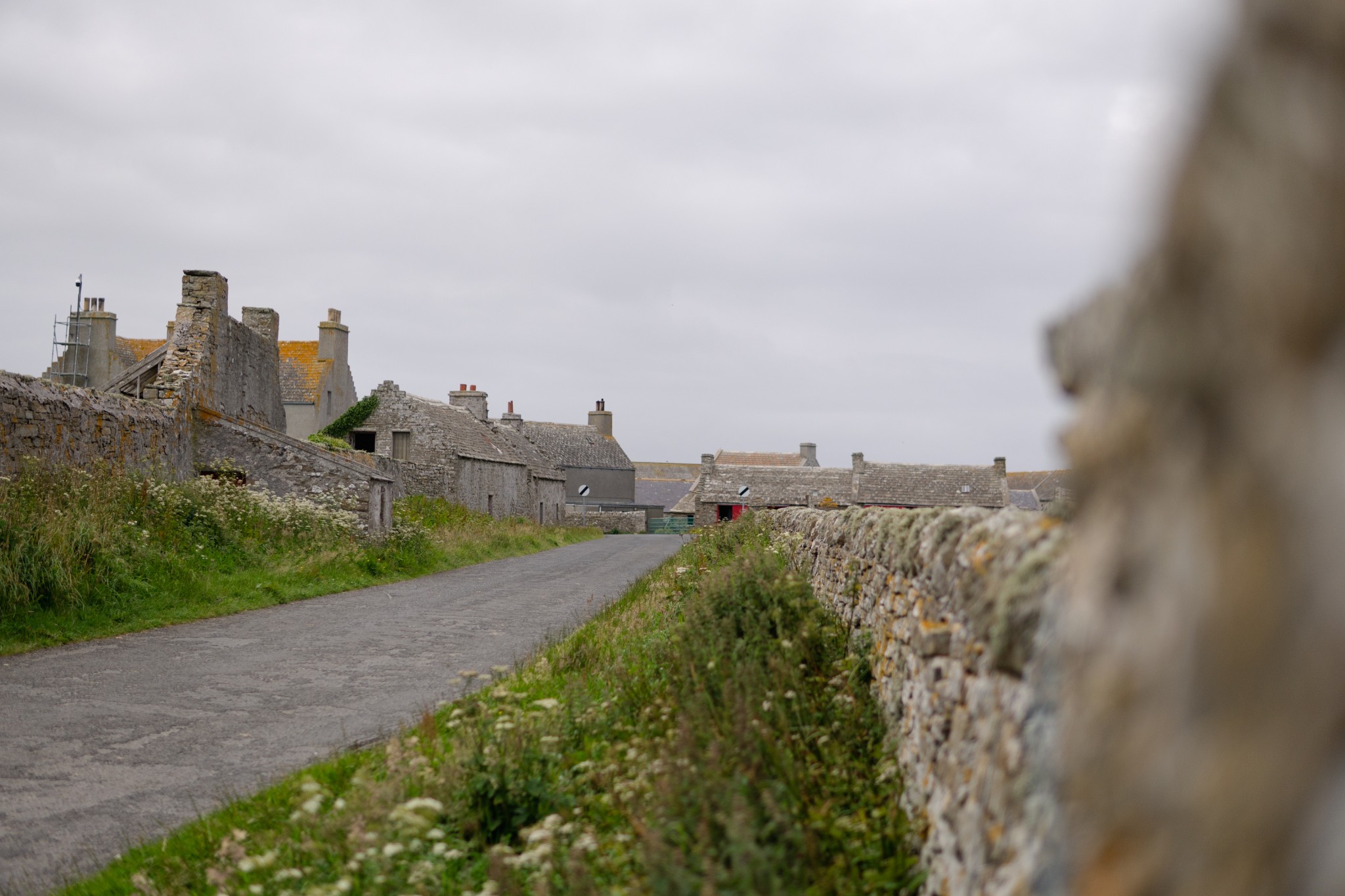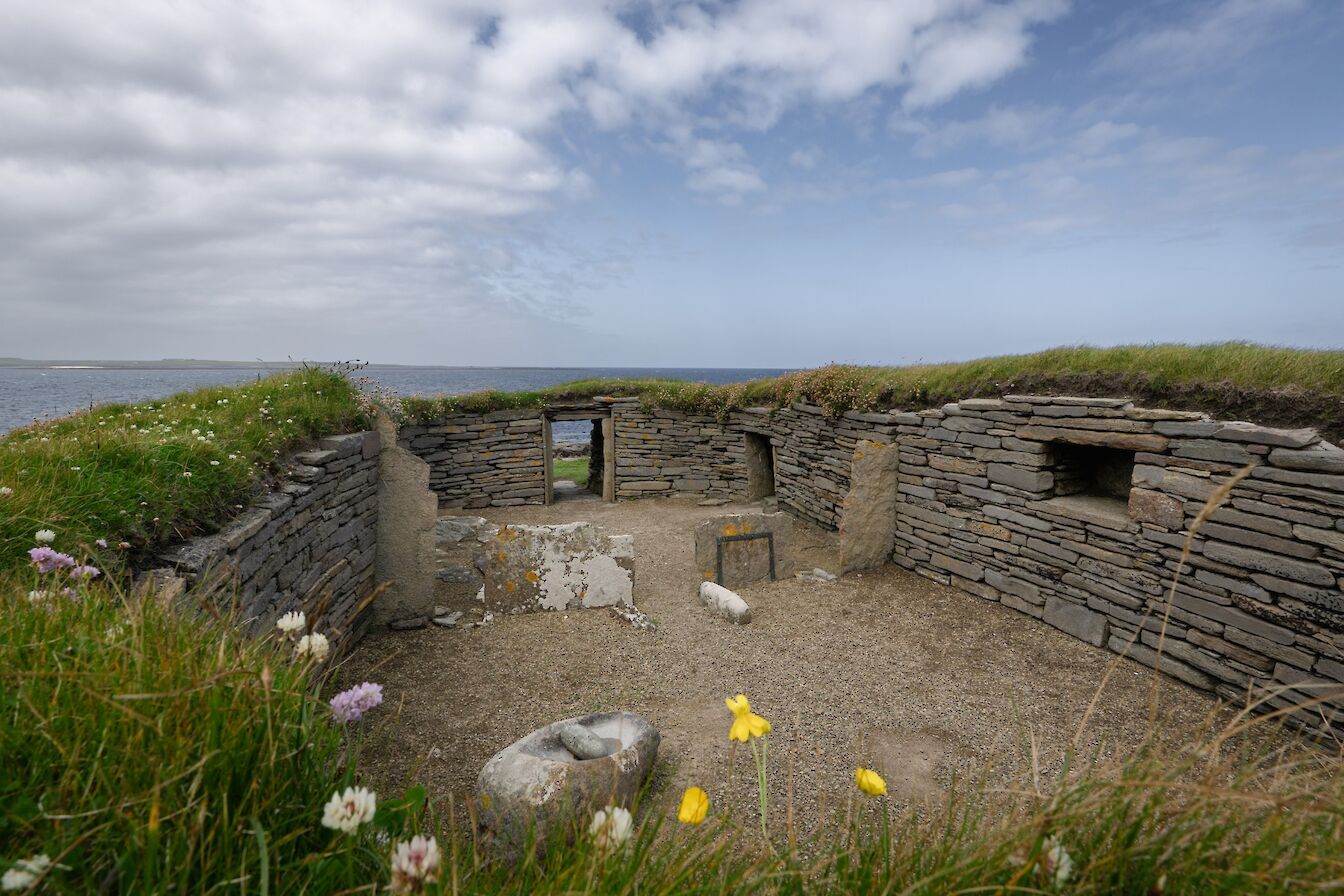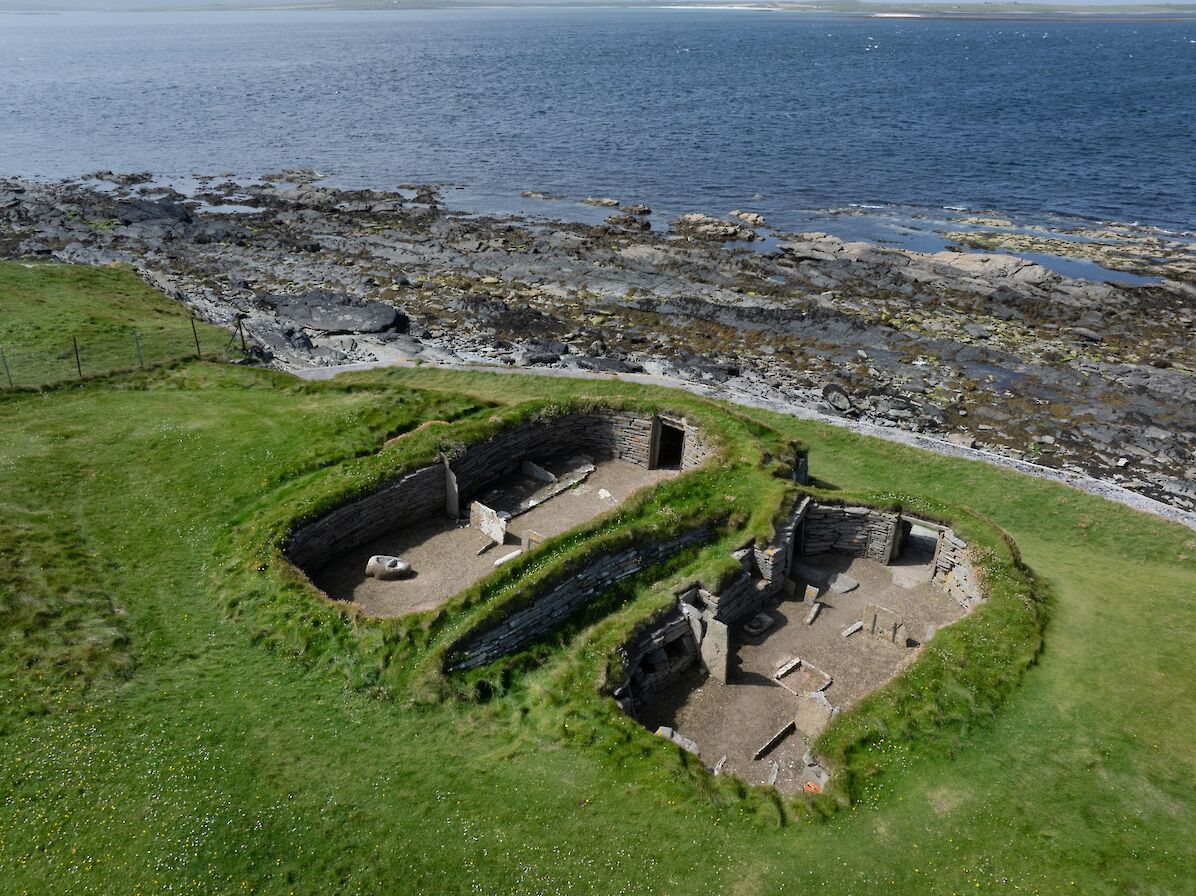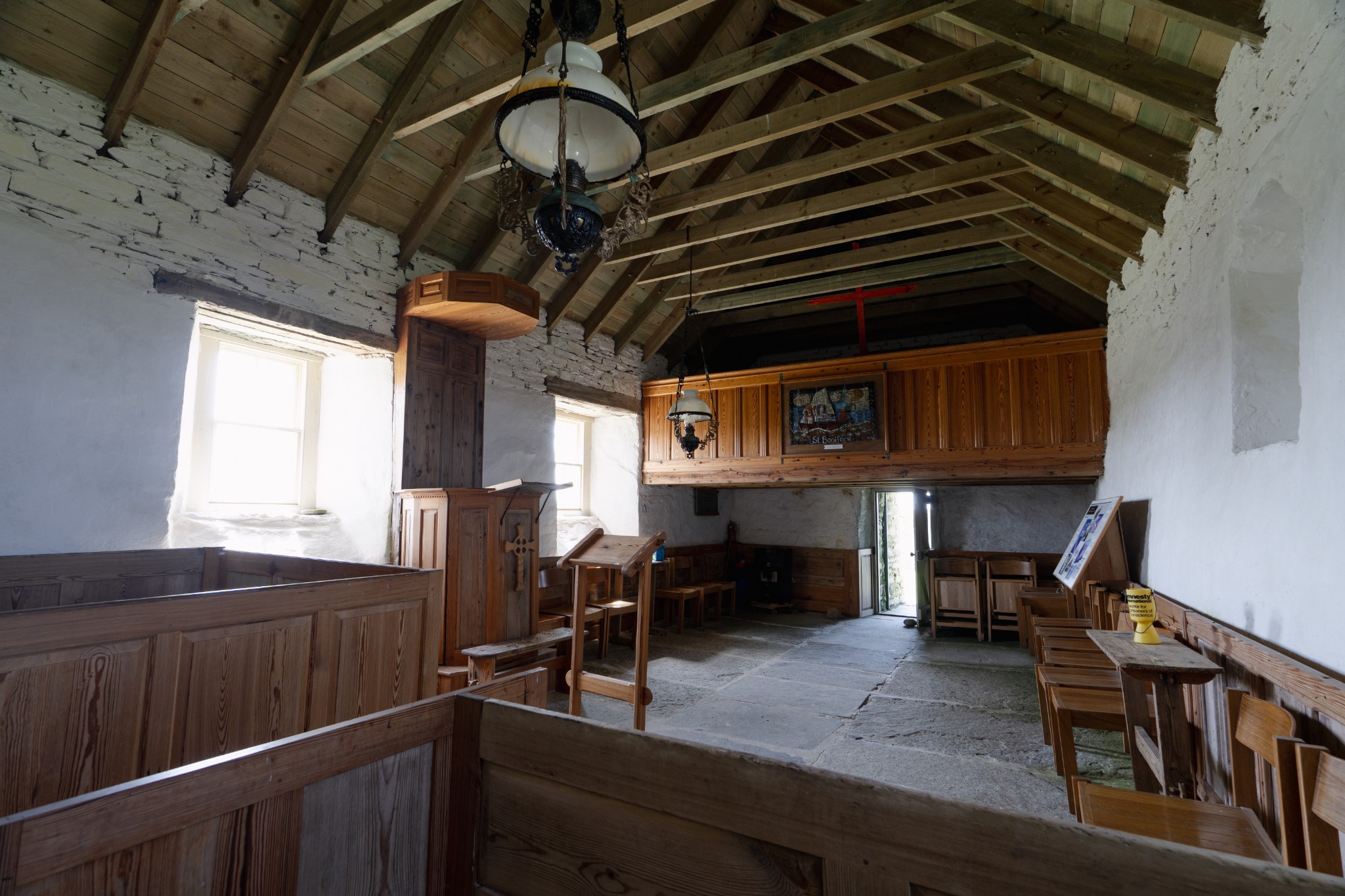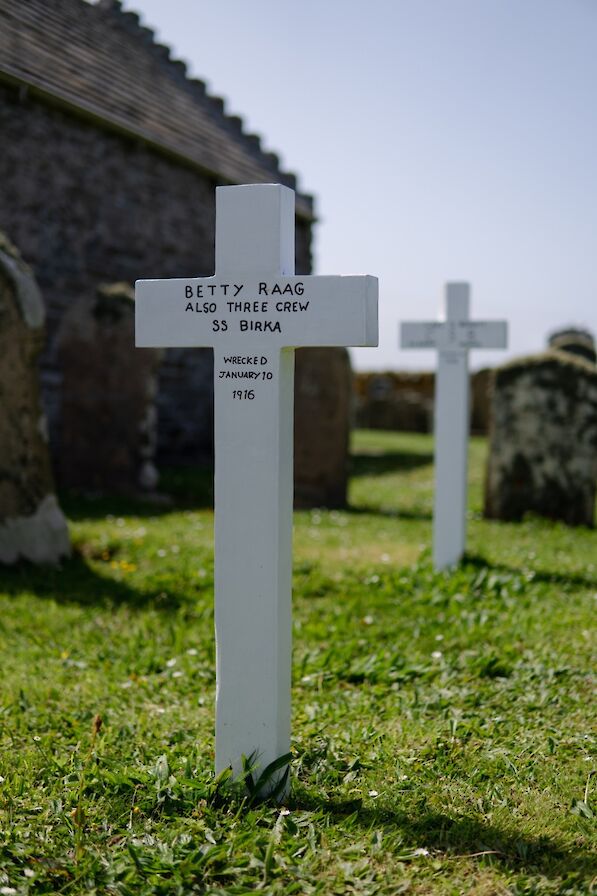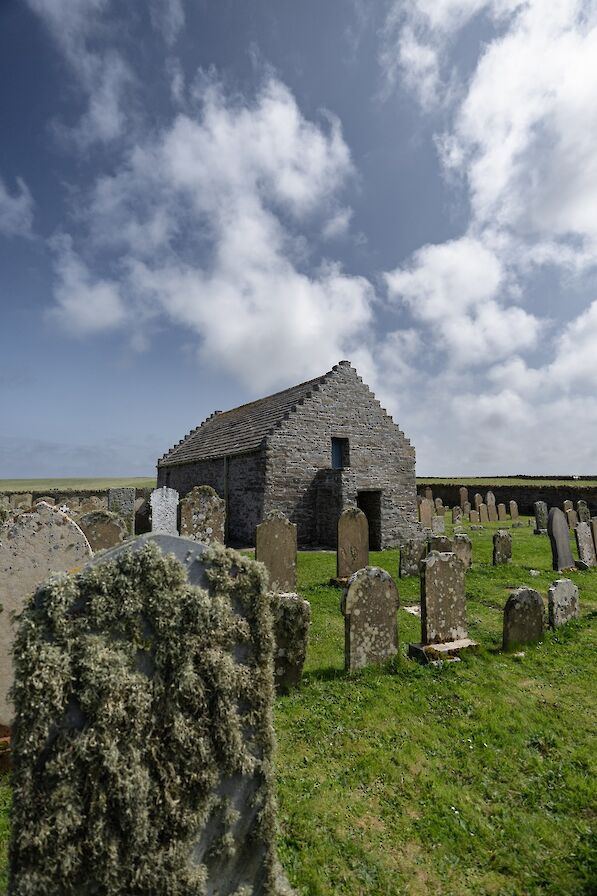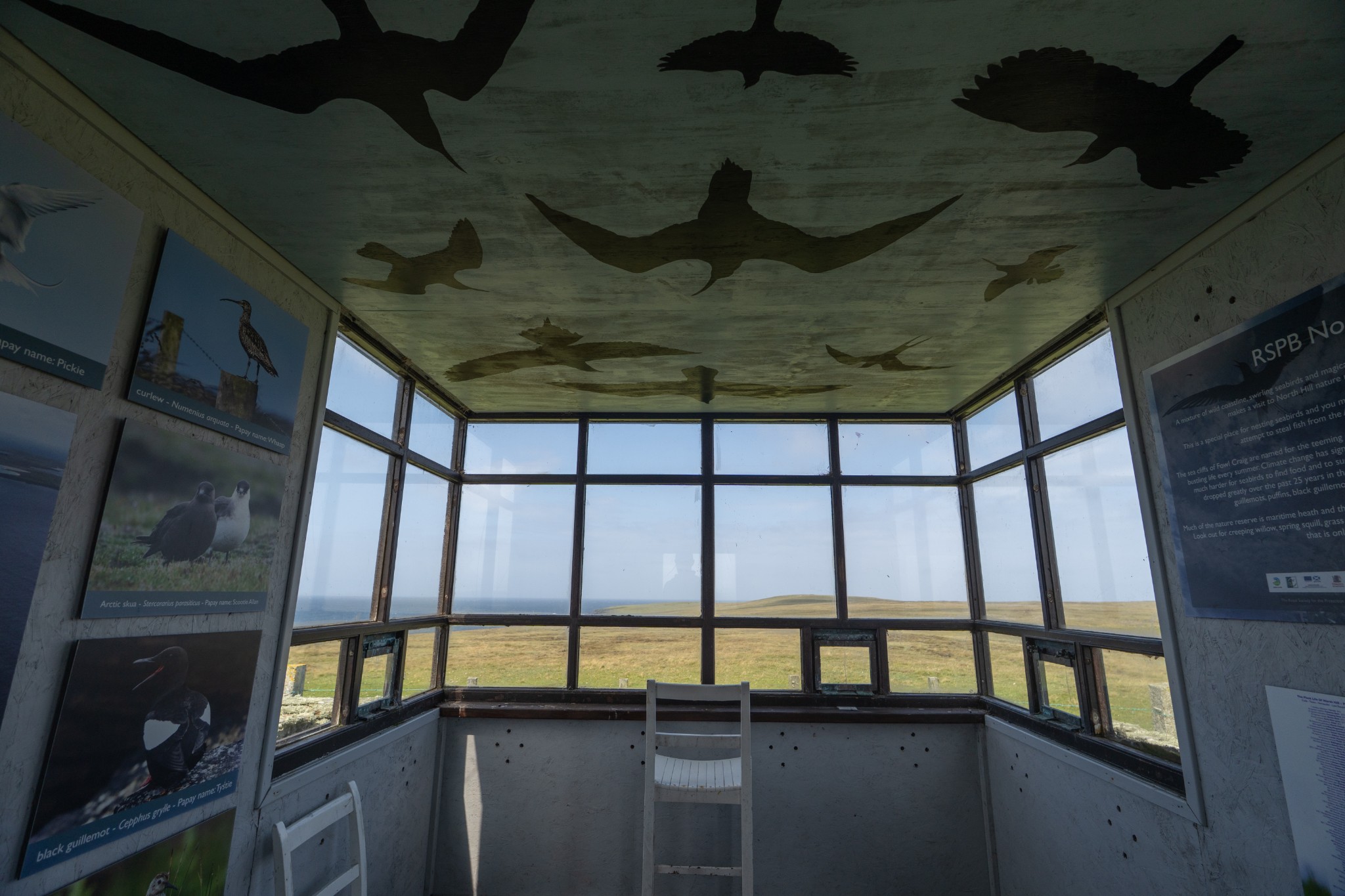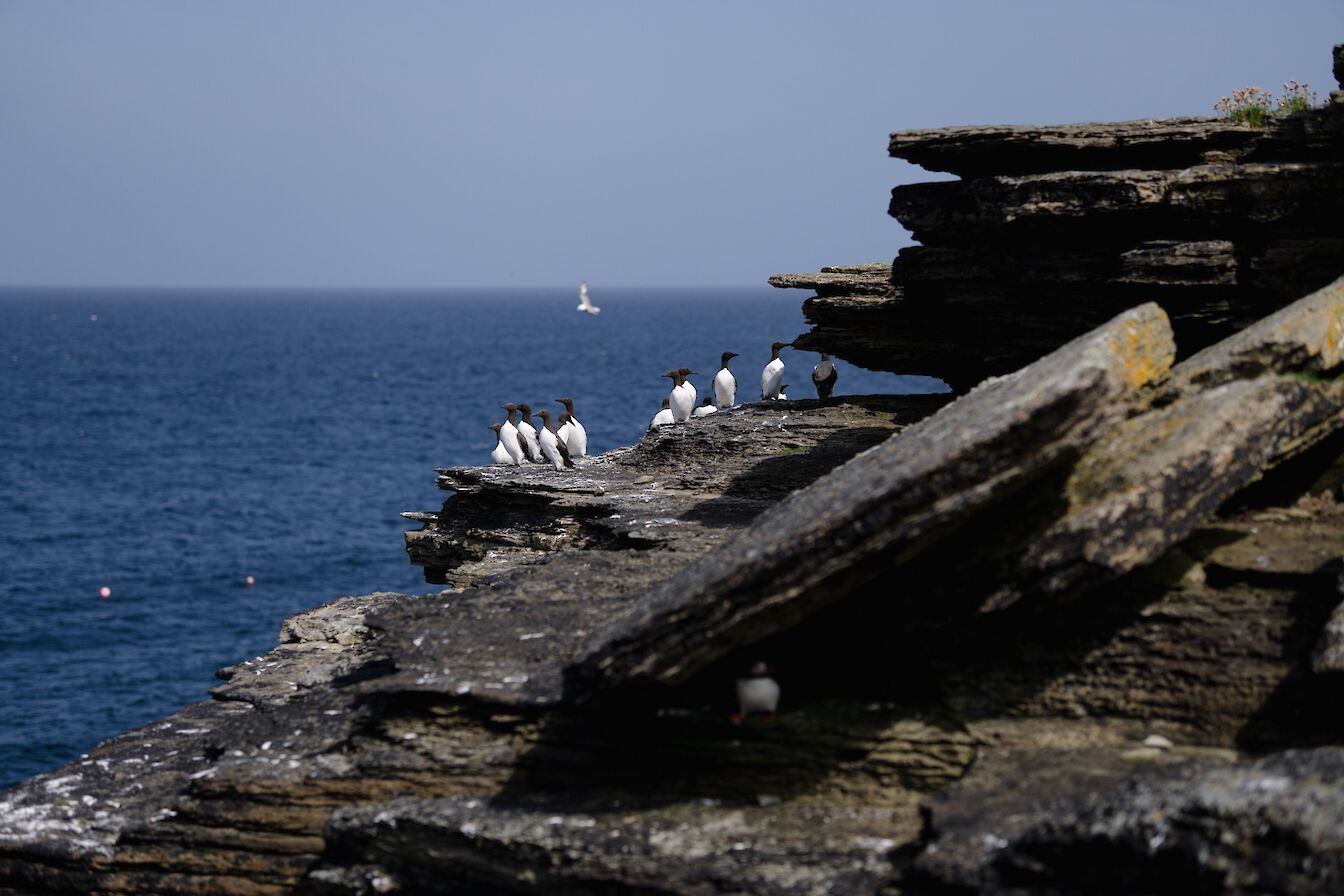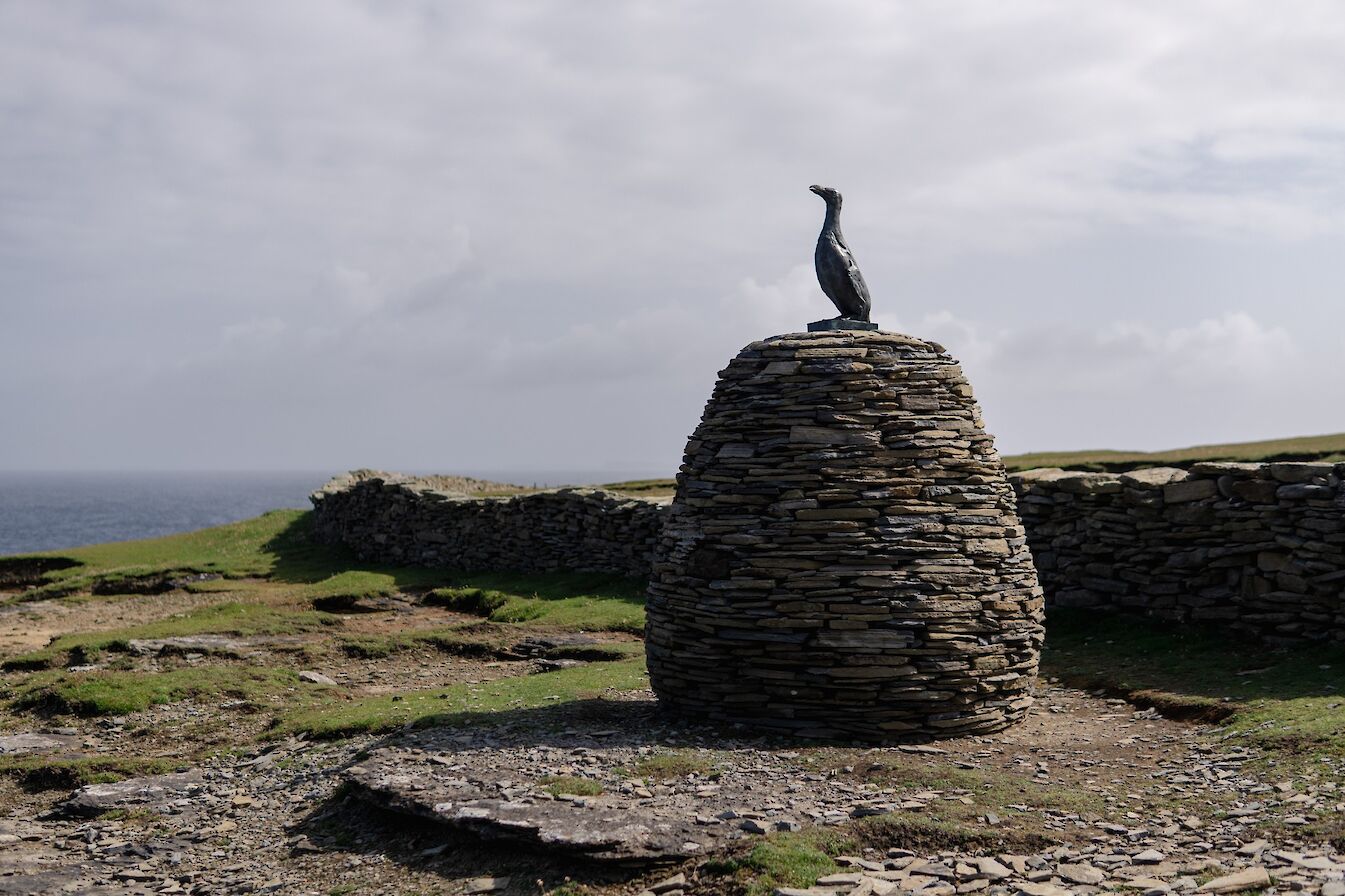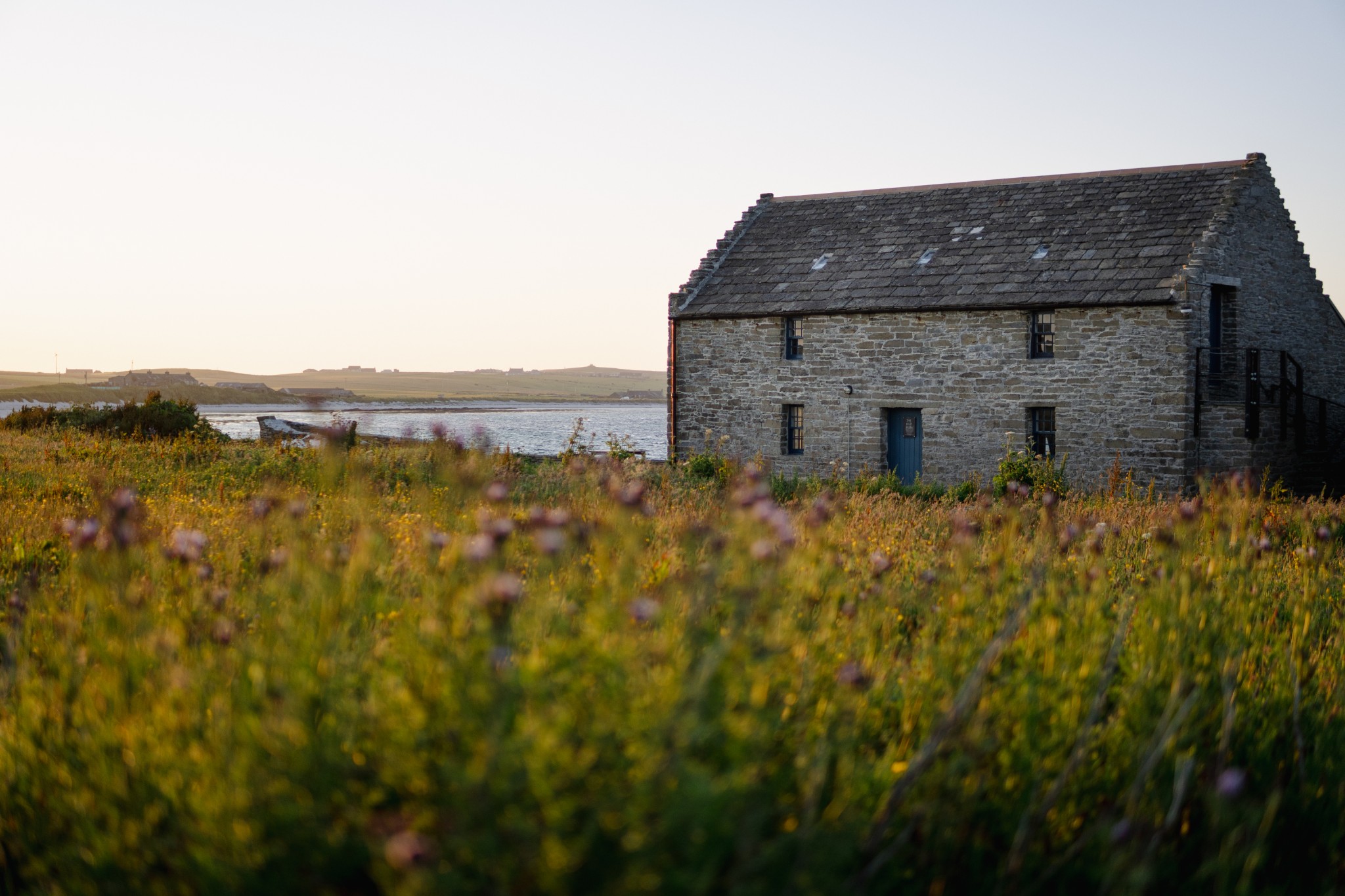A walk of rich and varied landscape, nature, and human history.
Despite being one of Orkney’s smallest inhabited islands, Papa Westray – referred to locally simply as ‘Papay’ – crams in an immense amount of history within its compact shoreline.
This walk takes in the northern half of the island, and includes Europe’s oldest standing buildings, a beautifully restored church dating back to Viking times, and the story of Britain’s last great auk.
Our walk starts at the excellent Papay Hostel and cooperative shop. From the shop head westwards, uphill, for about 250m until you come to the junction. Turn left, and after passing between the historic Holland House and its farm buildings look for a sign on your right directing you down a track to the Knap o’ Howar.
As you pass carefully through the farmyard, look for the small museum on your righthand side. John o Holland’s Bothy Museum holds a charming collection of artefacts, giving a sense of life in the island over recent centuries – the perfect prelude to the journey further back in time which is about to follow.
Continue shoreward along the track to a farm gate, then cross diagonally over a field to reach the obvious metal kissing gate at the Knap o' Howar, perched on the island’s shore.
The two oblong structures date to around 3600BC and are incredibly well-preserved. Looking at the freshness of the stonework it’s hard to believe that these are the oldest standing buildings in Europe. They were discovered in the 1930s, as erosion by the sea began to reveal midden and stonework.
One of the great joys of the Knap o’ Howar is that you can actually wander inside the structures themselves. Standing inside gives an added sense of how it must have felt to live in these simple, yet surprisingly homely stone houses.
Go back out the gate before turning left to head north up the coast. You’ll pass the island’s airstrip on your right-hand side, and you may see the small, Islander aircraft making the short hop between there and the neighbouring island of Westray. The world’s shortest scheduled flight, it lasts just 90 seconds or so. That’s not long to take in the beauty of Papa Sound, but thankfully you have plenty time to admire this stretch of water on the kilometre or so before reaching St Boniface Kirk (2.1km.) At the far side of the kirkyard you’ll find a wooden stile which leads to a metal gate into the grounds.
A modest stone building set in a small graveyard is in fact a 12th century chapel, extended in the early 19th century. It fell out of use in the 1920s, but was restored by the local community in the 1990s. The interior is wonderfully atmospheric, with a small gallery served by a door at the top of a small external staircase. The kirk is occasionally used for local events such as concerts and is always open to the public, with donations for the building’s upkeep being very welcome.
The graveyard contains a rare Norse-style hogback grave. Look out too for a pair of simple wooden crosses. These mark the graves of the crew of a Swedish steamer, SS Birka. She ran aground just across the water on Westray’s Bow Head in 1916, breaking up almost immediately in the strong northwest gale. There were no survivors, and the following day the bodies of five of the crew, and the captain’s wife, Betty Raag, were washed ashore in Papay. They were buried here, under these simple, poignant crosses. There have been many lives lost on this dangerous coastline – but also many more saved through the bravery of the local community. You can learn more about Papay’s shipwrecks at the island’s heritage exhibition within the superb Kelp Store.
Keep heading north from St Boniface until the patchwork of fields ends, and you emerge onto a wide expanse of coastal heath. This is the RSPB’s North Hill reserve (3.3km.) After crossing the last of the stone dykes turn right, bearing northeast, towards a wooden hut on top of the hill. This was the former coastguard lookout and now provides a welcome sanctuary for bird-watchers. It’s the perfect place to stop for a lunch break, and to admire the view southwards back across the island.
From the hide, pick up the faint cattle tracks to head northeast on a diagonal line back towards the shore. Follow the coast north towards Mull Head (5.6km), admiring the tortured geology of Brinkwall enroute. Enjoy open views of the Atlantic, as groups of gannets cruise by, before folding suddenly and dropping into the swells below.
The reserve is home to puffins, kittiwakes and Arctic terns. Look out too for the wonderful range of wildflowers, including the tiny primula scotica, found only in some parts of Orkney and Caithness.
Follow the coast east then south for around 1.5km where you’ll meet a sturdy wooden stile which crosses a fine dry-stone dyke.
This is Fowl Craig (6.8km), and it was here, in 1813, that one of Britain’s last great auks was shot. Six years later its stuffed remains were bought by the Natural History Museum, and it’s the only British specimen still in existence. Thankfully, these days this coastline is a safe refuge for our remaining seabirds, but a statue of the Papay auk has recently been erected, standing atop a beautifully crafted drystone cairn, the shape of the bird’s egg.
It’s a reminder of the fragility of many seabird species, which continue to suffer the effects of mankind’s actions.
Carry on south along the coast, with the wall to your right. After around 200m you’ll arrive at a pair of stout stiles. Cross the second of these, which keeps following the coast to pass a series of sheepfolds at the head of a storm beach. The Loch of Ness on your righthand side is a fine spot for spotting various species of wetland bird.
You’ll shortly arrive at the sweeping bay of North Wick (8.5km). If the tide is high you can walk along the grassy margin at the top of the beach, otherwise stick to the sand. After around 500m, before you reach the first headland, leave the beach to join the road which runs parallel to the shore, before becoming a sandy track as it continues southward to reach the Kelp Store (10.6km). This sympathetically restored building provides a real focal point for the community. As well as being a venue for a host of community and arts events it also has a wealth of information on the island’s human and natural history.
From the Kelp Store, pick up the tarmac road to head east past the craft shop, Post Office and school (look out for the amazing murals on a machinery shed shortly before the Post Office), then uphill to arrive back at the hostel.
Visit the Scottish Outdoor Access Code website for more information and advice on how to enjoy the outdoors responsibly.
Further information
- Places of interest
Papay is only four-miles-long and around a mile-wide, making it one of Orkney’s smallest inhabited islands. From ancient sites to wonderful nature and wildlife, you won’t be short of options if you’re planning a visit to this beautiful island.
A walk around St Tredwell’s Loch is well worth the effort too. It features the ruins of a chapel, found on a small mound jutting out into the loch. The loch itself has long been a site of pilgrimage with many myths and legends attached to it.
North and South Wick are neighbouring stretches of sand on the island’s east coast with azure water and shallow bays, perfect for paddling or snorkelling. At the southern end of Papay you’ll find the Bay of Moclett and Bothican beach. It’s a sheltered sweep of sand overlooking the island’s pier with views south towards Westray.
The best way to see all of the above and the locations detailed on the walking route is to book a spot on one of the excellent tours offered by the island’s ranger, Jonathan Ford.
He’ll meet you off the ferry or flight before showcasing everything Papa Westray has to offer, along with plenty of facts, figures, folklore and a keen eye for spotting local wildlife too. Tours are available during the summer months and possibly out of season too – just contact Jonathan directly to find out more. Booking is essential.
Boat tours to the neighbouring Holm of Papay are available too, giving you the chance to explore this uninhabited island and its Neolithic burial cairn.
- Food & drink
The Papay Shop should be your first stop for food and drink if you’re visiting the island. Phone 01857 644 321 to check opening times. There are currently no eating out options in Papay.
The weekly island coffee morning is held at St Ann’s Kirk every Wednesday morning at 1030, with teas, coffees and home bakes on offer. There is a weekly pub at Beltane House, the island hostel, on Saturday nights from 8pm where visitors can join local folk and enjoy Orkney beers, whiskies, gins, and a selection of soft drinks.
- Transport & services
Orkney Ferries operates sailings from Kirkwall to Papa Westray on Tuesdays and Fridays (note – there is no ro-ro facility in Papa Westray, so if you have a vehicle it will have to be brought off the ferry by crane). Depending on the day and time of year, these sailings often call in past Westray or North Ronaldsay on either leg of the journey, so do check in advance if planning a trip.
There are daily passenger-only crossings between Gill Pier in Westray and Papa Westray, with a connecting bus service linking the ferry terminals in Westray. Bicycles are accepted on both services. View timetables and book tickets on the Orkney Ferries website.
Loganair offers daily return flights between Papa Westray and Kirkwall, with most services connecting via Westray which offers the chance to experience the world’s shortest scheduled flight. Advance booking for all inter-isles flights in Orkney is essential, particularly during the summer months. View timetables and book online via the Loganair website.
There are two public toilets available in Papa Westray. At the school you’ll find one accessible unisex toilet, and at the island’s pier there’s one gents’ toilet, and one ladies’/accessible toilet. Petrol and diesel are available at the Papay Shop – phone 01857 644 321 to check opening times and availability.
